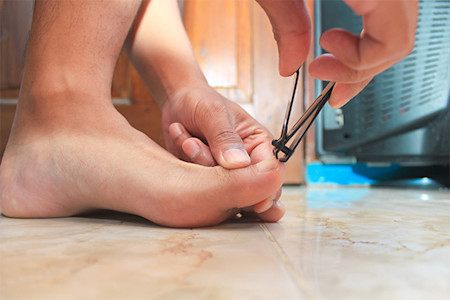Nail fungus: Causes
The fungi that cause nail fungus are found in everyday places.
You can pick it up in many ways, including sharing nail clippers that haven’t been properly sanitized.

What causes nail fungus?
Nail fungus, medical name onychomycosis, is caused by several types of fungi. These fungi grow in moist, warm places like people’s nails. The fungi can also thrive on everyday objects like unwashed shower floors, nail-grooming tools, and towels. This makes nail fungus contagious.
How do you catch nail fungus?
You get this condition when you have a microscopic opening in (or under) a nail or the skin around a nail. The fungi get in when you touch an infected person or item.
Many people pick up these fungi when they:
Touch a fungal infection on someone else’s skin or nail. If someone has nail fungus or athlete’s foot (a fungal skin infection on the feet), you can get infected when you touch the fungus on them.
Walk barefoot on a floor contaminated with fungi. The types of fungi that cause nail fungus thrive in warm, moist places. If you walk barefoot on a pool deck, in a locker room, or in a public shower, you can pick up fungi that can cause nail fungus.
Use a contaminated item. Some people develop nail fungus after sharing an unwashed towel, shoes, or a nail-grooming tool like a nail clipper that hasn’t been properly disinfected.
Develop moist feet or hands. When your skin stays wet or sweaty for long periods, you can develop a fungal infection. For example, if you wear wet shoes or gloves, keep sweaty socks on, work at something that keeps your hands wet, or have a condition called hyperhidrosis (excessive sweating), fungi can grow uncontrolled. If fungi spread to a break in your nail or the skin around a nail, you can develop nail fungus.
Have athlete’s foot. Athlete’s foot is a skin infection that causes flaky skin, cracks, and itchiness on the feet. If you have a mild infection, you may think you have dry feet. This condition often develops between the toes. If the fungi that cause athlete’s foot slip into an opening in or under a nail, you can develop nail fungus, too.
Who gets nail fungus?
Anyone can develop nail fungus. However, the condition is much more common in adults than in children.
Board-certified dermatologist Shari Lipner, MD, PhD, FAAD, specializes in treating nails. She says, “Children rarely get onychomycosis (nail fungus).” She adds that when a child has nail fungus, it’s likely that one of the parents has it.
While rare in kids, the likelihood of getting nail fungus increases with age. About 50% of people over 70 years of age develop nail fungus. This increase is due to changes that occur with age. Our nails grow more slowly, and we have less ability to fight off infections.
Age isn’t the only reason for an increased risk. You have a greater likelihood of developing nail fungus if you:
Have a nail injury or bunion — or had nail fungus before.
Let your nails grow long or cut them improperly.
Share nail-grooming tools without properly disinfecting them.
Frequently wear tight shoes or shoes that make your feet sweat
Walk barefoot in locker rooms, shared showers, or other warm, moist areas like pool decks.
Have one of these skin conditions: Athlete’s foot, hyperhidrosis (excessive sweating), psoriasis.
Have cancer, diabetes, poor circulation, peripheral artery disease, obesity, or inflammatory bowel disease.
Have relatives who have had nail fungus.
If you develop nail fungus, a cure is more likely with early treatment. Getting the right treatment requires an accurate diagnosis. Nail fungus can look like another condition, such as nail psoriasis. Your board-certified dermatologist knows how to diagnose nail conditions and provide treatment that brings relief.
To find out what to expect when you see a dermatologist, go to Nail fungus: Diagnosis and treatment.
Image
Getty Images
References
Evans A. “What's the fuss about fungus?” Dermatol World. 2024 Jan;34(1):22-9.
Falotico JM, Lipner SR. “Updated perspectives on the diagnosis and management of onychomycosis.” Clin Cosmet Investig Dermatol. 2022 Sep 15;15:1933-57.
Stewart CR, Algu L, et al. “Effect of onychomycosis and treatment on patient-reported quality-of-life outcomes: A systematic review.” J Am Acad Dermatol. 2021 Nov;85(5):1227-39.
Written by:
Paula Ludmann, MS
Reviewed by:
William Warren Kwan, MD, FAAD
Shari Lipner, MD, PhD, FAAD
Temitayo Ogunleye, MD, FAAD
Last updated: 6/26/25
 Atopic dermatitis: More FDA-approved treatments
Atopic dermatitis: More FDA-approved treatments
 Biosimilars: 14 FAQs
Biosimilars: 14 FAQs
 How to trim your nails
How to trim your nails
 Relieve uncontrollably itchy skin
Relieve uncontrollably itchy skin
 Fade dark spots
Fade dark spots
 Untreatable razor bumps or acne?
Untreatable razor bumps or acne?
 Tattoo removal
Tattoo removal
 Scar treatment
Scar treatment
 Free materials to help raise skin cancer awareness
Free materials to help raise skin cancer awareness
 Dermatologist-approved lesson plans, activities you can use
Dermatologist-approved lesson plans, activities you can use
 Find a Dermatologist
Find a Dermatologist
 What is a dermatologist?
What is a dermatologist?